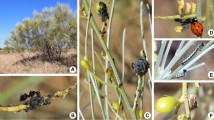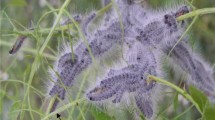Abstract
In a cottonwood (Populus) hybrid zone, Chaitophorus aphids attract aphid-tending ants which subsequently reduce herbivory by the leaf-feeding beetle, Chrysomela confluens. Observations and experimental manipulations of aphids and beetle larvae on immature cottonwood trees demonstrated that: 1) via their recruitment of ants, aphids reduced numbers of beetle eggs and larvae on the host; 2) these interactions occurred within a few days of the host being colonized by aphids; and 3) although aphid colonies were ephemeral, their presence resulted in a 2-fold reduction in beetle herbivory. The aphid-ant interaction is most important in the hybrid zone where 93% of the beetle population is concentrated (for reasons unrelated to aphids and ants). Because beetle defoliation of immature trees is high (ca. 25%), the indirect effect of aphids in reducing herbivory is likely more beneficial to trees in the hybrid zone than in adjacent pure zones where beetle herbivory is virtually absent. Tree genotype likely affects the impact of the aphid-ant interaction on trees within the hybrid zone, since levels of herbivory differ between sympatric Fremont and hybrid cottonwoods.
Similar content being viewed by others
References
Banks CJ, Macaulay EDM (1967) Effects of Aphis fabae Scop. and of its attendant ants and insect predators on yields of field beans (Vicia faba L.). Ann appl Biol 60:445–453
Barbosa P, Wagner MR (1989) Introduction to Forest and Shade Tree Insects. Academic Press, New York, 639 pp
Bradley GA (1973) Effect of Formica obscuripes (Hymenoptera: Formicidae) on the predator-prey relationship between Hyperaspis congressis (Coleoptera: Coccinellidae) and Toumeyella numismaticum (Homoptera: Coccidae). Can Entomol 105:1113–1118
Bray JR (1961) Measurement of leaf utilization as an index of minimum level of primary consumption. Oikos 12: 70–74
Compton SG, Robertson HG (1988) Complex interactions between mutualisms: Ants tending homopterans protect fig seeds and pollinators. Ecology 69:1302–1305
Cushman JH (1991) Host-plant mediation of insect mutualisms: variable outcomes in herbivore-ant interactions. Oikos 61:138–144
Cushman JH, Addicott JF (1991) Conditional interactions in antplant-herbivore mutualisms. In: Huxley CR, Cutler DF (eds) Ant-Plant Interactions. Oxford University Press, New York, pp. 92–103
Cushman JH, Whitham TG (1989) Conditional mutualism in a membracid-ant association: Temporal, age-specific, and density-dependent effects. Ecology 70:1040–1047
Degen AA, Gersani M, Avivi Y, Weisbrot N (1986) Honeydew intake of the weaver ant Polyrhachis simplex (Hymenoptera: Formicidae) attending the aphid Chaitophorous populialbae (Homoptera: Aphididae). Insectes Soc 33:211–215
Edinger BB (1985) Conditional mutualism in three aphid-tending ants. Bull Ecol Soc Am 66:168
Floate KD, Kearsley MJC, Whitham TG (1993) Elevated herbivory in plant hybrid zones: Chrysomela confluens, Populus and phenological sinks. Ecology 74:2056–2065
Fowler SV, MacGarvin M (1985) The impact of hairy wood ants, Formica lugubris, on the guild structure of herbivorous insects on birch, Betula pubescens. J Anim Ecol 54:847–855
Fritz RS (1983) Ant protection of a host plant's defoliator: consequence of an ant-membracid mutualism. Ecology 64:789–797
Hölldobler B, Wilson EO (1990) The ants. The Belknap Press of Harvard University Press, Cambridge, 732 pp
Ito F, Higashi S (1991) An indirect mutualism between oaks and wood ants via aphids. J Anim Ecol 60:463–470
Kearsley MJC, Whitham TG (1989) Developmental changes in resistance to herbivory: Implications for individuals and populations. Ecology 70:422–434
Kearsley MJC, Whitham TG (1993) Guns and butter: A no cost defense against predation for Chrysomela confluens. Oecologia 92:556–562
Keim P, Paige KN, Whitham TG Lark KG (1989) Genetic analysis of an interspecific hybrid swarm of Populus: Occurrence of unidirectional introgression. Genetics 123:557–565
Messina FJ (1981) Plant protection as a consequence of an antmembracid mutualism: interactions on goldenrod (Solidago sp.). Ecology 62:1433–1440
Morrow PA, Fox LR (1989) Estimates of pre-settlement insect damage in Australian and North American forests Ecology 70:1055–1060
Paige KN, Keim P, Whitham TG, Lark KG (1990) The use of restriction fragment length polymorphisms to study the ecology and evolutionary biology of aphid-plant interactions. In: Campbell RK, Eikenbary RD (eds) Aphid-Plant Interactions. Elsevier Amsterdam, pp 69–87
Rice WR (1989) Analyzing tables of statistical tests. Evolution 43:223–225
Room PM (1972) The fauna of the mistletoe Tapinanthus bangwensis (Engl. & Krause) growing on cocoa in Ghana: Relationships between fauna and mistletoe. J Anim Ecol 41:611–621
Samways MJ (1983) Interrelationship between an entomogenous fungus and two ant-homopteran (Hymenoptera: Formicidae-Hemiptera: Pseudococcidae & Aphididae) mutualisms on guava trees. Bull ent Res 73:321–331
Tedders WL, Reilly CC, Wood BW, Morrison RK Lofgren CS (1990) Behavior of Solenopsis invicta (Hymenoptera: Formicidae) in pecan orchards. Environ Entomol 19:44–53
Vrieling K, Smit W, Van der Meijden E (1991) Tritrophic interactions between aphids (Aphis, jacobaeae Schrank), ant species, Tyria jacobaeae L., and Seneclo jacobaea L. lead to maintenance of genetic variation in pyrrolizidine alkaloid concentration. Oecologia 86:177–182
Whitham TG (1989) Plant hybrid zones as sinks for pests. Science 244:1490–1493
Whittaker JB, Warrington S (1985) An experimental field study of different levels of insect herbivory induced by Formica rufa predation on sycamore (Acer pseudoplatanus). III. Effects on tree growth. J Appl Ecol 22:797–811
Author information
Authors and Affiliations
Rights and permissions
About this article
Cite this article
Floate, K.D., Whitham, T.G. Aphid-ant interaction reduces chrysomelid herbivory in a cottonwood hybrid zone. Oecologia 97, 215–221 (1994). https://doi.org/10.1007/BF00323152
Received:
Accepted:
Issue Date:
DOI: https://doi.org/10.1007/BF00323152




